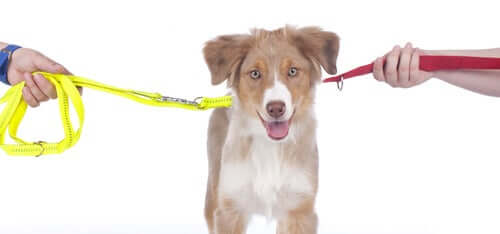Joint Custody of a Pet: What Is It and How Does It Work?

Joint custody of a pet is a relatively new legal procedure. It’s now as common as child custody procedures when it comes to dissolving a marriage.
Unfortunately, this new legal circumstance goes well beyond a question of who gets to keep the pet for those involved.
Today, we’d like to explain the common issues people face when it comes to joint custody. We’ll give you the specs of shared guardianship after the dissolution of a marriage or partnership.
The law in regard to joint custody of a pet
Current laws protect the best interests of children who are entangled in divorce cases, but the laws for pets mainly benefit their owners. The law still considers animals to be personal property and humans can own and control them.
Courts can only award a pet to its rightful legal owner. Granting joint custody or visitation rights to a couple’s pets is exactly the same, in the eyes of the law, as having them trade their television back and forth from one week to the next.
Before a court decides who gets what after a divorce, it must first consider whether the pet was communal property. They need to decide if they can split it 50/50 or if they need a more equitable ratio of distribution. Also, they must decide which property actually belongs to the couple as such. In addition to that, the value of each piece of property.
Finally, the court will take into account whether there’s a prenup or some other legal agreement. So, when it comes to deciding who gets to keep the family pets, any court of law will use the same rules they would when dividing any other assets.
These conflicts are quite common in the shared acquisitions of horses dedicated to competing in sports. So, you should always make a legal contract before acquiring an animal with another person in order to avoid a future legal battle.
Divorce: who gets to keep the animal?

The conditions of the joint custody and their duties must be clearly and objectively specified in the body of a legal contract if you want to prevent future costly legal disputes.
The first thing to make clear in such contracts is that any financial contributions made by either party involved in joint custody should be stated. These fees are essential when it comes to determining what corresponds to each person in the event of contract termination.
In addition, they also help regulate the responsibilities of each guardian in regards to the financial support for the animal. Likewise, the law assumes that the financial investment of each co-owner was the same. However, if this isn’t the case, then the parties must specify the percentage of investments in the contract, along with their duties and rights.
In regard to duties and rights, the law enforces the stipulated clauses in such contracts, as a general rule. It also provides them with a right to delegate their own responsibilities to a second party of their choosing on their own terms.
In the event of disagreement between partners, or if incoherent or arbitrary clauses were stated in the agreement, then either partner has the right to request a motion to void it. They would then receive compensation in proportion to their share in the co-ownership.
Sharing custody

Currently, there are many divorcees with legal joint custody of their pets. In these cases, the agreement states that pets are family members and not goods to divide.
The truth is that there are more and more instances of couples who elaborate prenups that cover their pets in the event of a separation. In these documents, the responsibilities and rights of each party are well-detailed in order to guarantee the animal is properly cared for.
Logically, this type of regulation also details the division of expenses. As in everything from animal nutrition to hygiene, welfare, and even preventative medicine. The bare necessities, that is.
Joint custody rules are also in place so that any termination of the bond between each member of a couple won’t affect their enjoyment of their pet.
In this regard, people should make an agreement in advance. One that states how each of them would spend workdays and weekends with their pets. Also, if there’ll be a meeting point for the purpose of collection and delivery of the animal.
They should also state any other practical issues that could prevent future conflicts between the parties in a break-up.
All these issues are quite innovative in our current legal system. It’s time to stop thinking of animals as objects and property and ascribe them the dignity we would our children. This is definitely a step closer to the full recognition that animals are sentient beings with rights.
All cited sources were thoroughly reviewed by our team to ensure their quality, reliability, currency, and validity. The bibliography of this article was considered reliable and of academic or scientific accuracy.
- Derecho animal. 2014. Custodia compartida sobre animales. Extraído de: https://ddd.uab.cat/pub/da/da_a2014v5n4/da_a2014v5n4a4.pdf
- Padres divorciados. Quién se queda con la mascota. Extraído de: http://www.padresdivorciados.es/pdf/Divorcio%20con%20Mascotas_%20C_n%20quien%20se%20queda%20el%20animal.pdf
